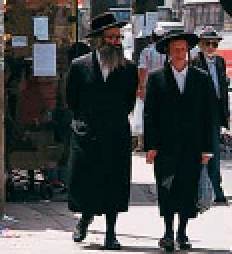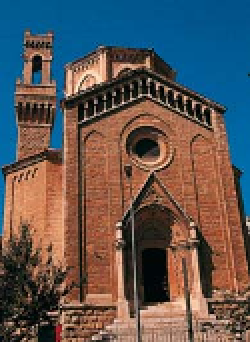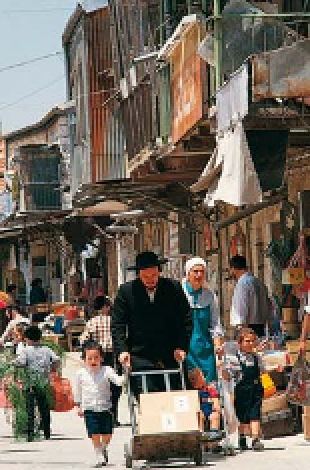Travel Reference
In-Depth Information
William Holman Hunt
(see
p33)
. It is now a private
residence and closed to the
public. A couple of minutes'
keep their hair covered
beneath a snood. The
streets either side of
main Mea Shearim
Street are narrow alley-
ways, which squeeze
between long, narrow
two-storey dwellings,
occasionally opening
out into washing-
strewn communal
courtyards. The area
is completely self
A
walk to the north, along
narrow, leafy Etyopya Street,
is Ben Yehuda House, named
Y
after the man responsible for
reviving popular usage of the
Hebrew language. This was
his residence in the early
years of the 20th century.
A little further up the lane
A
is the striking, round form of
the Ethiopian Church, which
sits in beautifully tended
gardens. It was built between
1873 and 1911, and is mod-
elled after churches in Ethiopia,
with its sanctuary clearly
separated from the main body
of the church. Just five minutes'
walk away, back on Ha-Neviim
Street, the Ethiopians also
have their consulate. It is
notable for a vivid blue and
gold mosaic on the façade
depicting the Lion of Judah.
f
contained, with its own
bakeries, markets, syna-
gogues and, although
no longer in use, its
own huge cistern.
Mea Shearim was
founded in the late 19th
century and built in
three stages, to a design
by Conrad Schick, for
Jews from Poland and
Lithuania. Until well into
this century the quarter was
shut off from the rest of the
city each night by six gates.
The gates are gone but
visitors should bear in mind
that this is still a very insular
community.Skirts should
reach below the knee, and
men must not wear shorts or
T-shirts. Discretion is advised
when taking photographs.
Northwest of Mea Shearim is
the Bukharan Quarter, founded
in the late 19th century by
wealthy Central Asian Jews.
Traces of its former grandeur
remain in some elegant, if
dilapidated, mansions.
Mea Shearim, the heartland of Jerusalem's
insular ultra-Orthodox community
Mea Shearim
q
Map
1 A1.
@
1.
Possibly the most unusual
district in all Jerusalem,
Mea Shearim is a perfectly
preserved, living model of
18th-century Jewish Eastern
Europe. It is a quarter
inhabited exclusively by
ultra-Orthodox Jews, where
the influence of the outside
world is kept to an absolute
minimum. Dress is traditional
in the extreme; many men
wear black stockings and
long black coats, and women
Italian Hospital
0
Corner of Ha-Neviim and Shivtei Yisrael
Sts.
Map
1 B2.
@
27.
¢
to public.
The grandest building of all
on Ha-Neviim Street is the
Italian Hospital. It was built
just before World War I to
underscore Italian presence in
the Holy City, at a time when
the colonial powers were
using architecture to assert
their influence and status.
Designed by prolific architect
Antonio Barluzzi, the hospital
is clearly inspired by the
Palazzo Vecchio in Florence.
The building now houses
the Ministry of Education.
ULTRA-ORTHODOX JEWS
The life of the ultra-Orthodox
(haredim)
is grounded in
rigorous observance of Judaic law and study of the Torah.
Their lifestyle involves an uncompromising rejection of
modern life and all its trappings, which means no television,
no cars and minimum intrusion by technology. The ultra-
Orthodox live and dress strictly according to traditions
practised in Eastern Europe
several centuries ago. This
lifestyle means that they
segregate themselves from
less observant Jews. More
radical factions are opposed
to the common use of
Hebrew, the “Holy tongue”,
and instead speak Yiddish;
some do not recognize the
State of Israel or its laws,
even refusing to pay taxes.
They claim that there can be
no true Jewish state until the
coming of the Messiah.
Ultra-Orthodox Jews dressed
in everyday attire
The extravagant Italian Hospital














